
Estimated reading time: 12 minutes
Eye-tracking research can sometimes feel like a bit of a terminological minefield, particularly if you are new to the topic. In this blog (the first of a series) I outline some of the key terms that refer to eye movements themselves. Future blogs will address the terminology around eye tracking data quality and eye-tracking analysis.
The Anatomy of Eye Movements
Our range of eye movements is a function of the eye’s anatomy – in particular, the well-known fact that the distribution of cone cells in the retina is such that visual acuity (our ability to see clearly) drops away very sharply from the small foveal region. As such, we need to be able to rapidly orient our foveal region to potentially informative regions of space, and keep our eyes in place (keep the region foveated) when we arrive there in order to process the visual input. In addition, we need to be able to track things that move and compensate for movements of our own head. These requirements determine the types of eye movements we can make, all of which are controlled by three pairs of extraocular muscles.
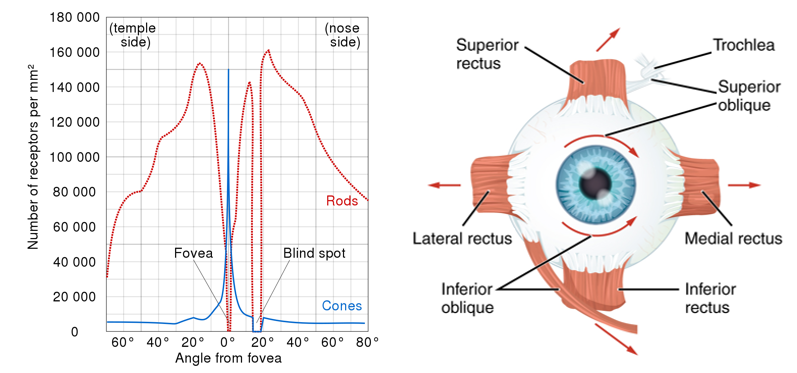
Types of Eye Movements
The following sections describe the main different types of eye movements that are of interest to eye-tracking researchers.
Saccades / Saccadic Eye Movements

The term saccade, from the french verb meaning “to jerk” was first used to describe eye movements by Javal in the 1880s. It refers to the very rapid, conjugate (both eyes do the same thing) eye movements we make when re-orienting the foveal region to a new spatial location. We typically make around 3 saccades each second. Saccades are often described as being “ballistic” movements, meaning that once launched, their trajectory cannot be altered. This turns out to be only somewhat true… Perhaps more importantly as far as eye-tracking is concerned, we are generally assumed to be “effectively blind” during saccades. Again, this also turns out to be only somewhat true, but it is common for saccade durations to be ignored when computing measures such as dwell time. Many eye-tracking researchers are most interested in knowing what was being looked at, and how long it was looked at for, and are less concerned with saccades themselves.
For some researchers though, saccades can be a very rich source of information, and common metrics include their latency, amplitude, direction and peak velocity (see illustration below). Amplitude and velocity are related by what is known as the “main sequence” – larger saccades have a higher peak velocity. Whilst saccades are typically represented by straight lines in “gaze overlay” visualizations of gaze data, saccade trajectories are often markedly curved – and this is another measure that can be of interest to researchers.
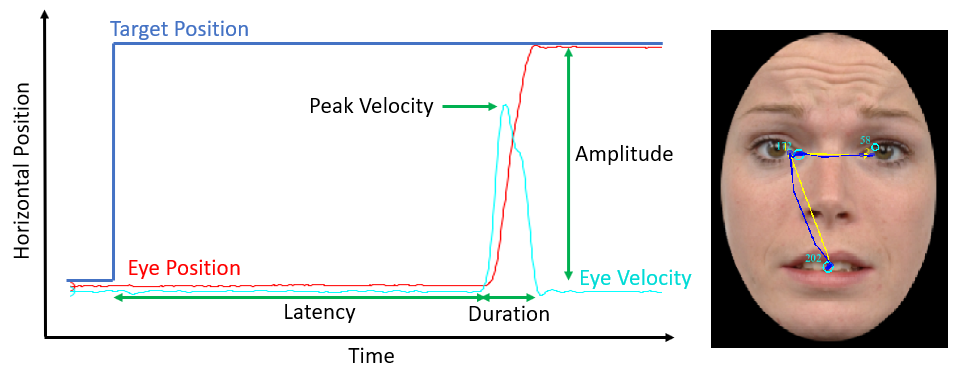
Perhaps the most confusing thing about a saccade is how it should be pronounced… both syllables can be evenly stressed or the stress can come on the second syllable. The “ade” syllable can be pronounced as in lemonade or (following its French roots) as in hard or as in mad. In my experience, these various pronunciations seem pretty evenly distributed across eye tracking researchers, and all are perfectly acceptable!
Fixations
Saccades are typically preceded and followed by a fixation – the term used to describe the period of relative stability during which visual information is processed. The rules and algorithms that researchers (and eye-tracking software) use to determine whether the eye is in a fixation or in a saccade can be complex and will be discussed in another blog. Fixations are typically 200-300ms but can be much shorter or much longer, and average fixation duration depends to some extent on the context – e.g. fixations are typically somewhat shorter during reading than when viewing scenes. Fixations are often what researchers focus on at the analysis stage – particularly if gaze is being used as a proxy for “attention”. Fixations are typically described by two key metrics: their location (which is defined as the average x and y locations of the samples they contain) and their duration. In standard visualization approaches, fixations are represented by circles, with the circle’s center at the average x,y location and its diameter reflecting the duration. The durations of fixations within an interest area are summed to produce the “dwell time”.
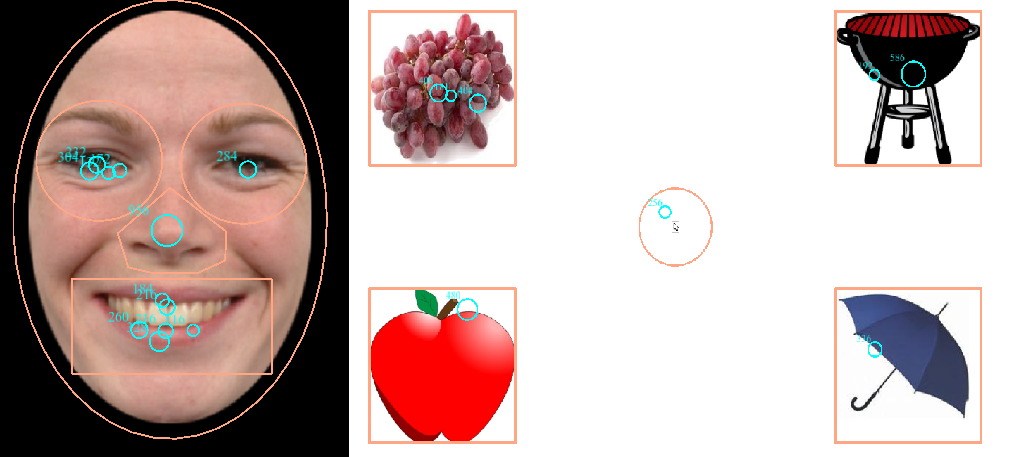
Somewhat confusingly, whilst saccades and saccadic eye movements are the same thing, fixations and fixational eye movements are not (see below).
Microsaccades / (Intra) Fixational Eye Movements
Representing fixations as circles with a fixed location can give the impression that the eye was completely still during the fixation. In reality, the eye is never truly still – and within a fixation, there can be both “drift” (slow changes in location) and microsaccades. As their name suggests, microsaccades are just like normal saccades, only smaller. How small a saccade has to be in order to count as a microsaccade is the topic of considerable debate, but less than 1 degree of visual angle is a reasonably common cutoff. They are of interest to researchers for a number of reasons. Their frequency and direction may provide useful insights into attentional processes, and they are a potential source of noise in EEG/MEG and even fMRI recordings. In order to be able to detect microsaccades, you need an eye tracker like the EyeLink 1000 Plus, that has a fast sampling rate and very high levels of precision. The image below zooms in on a single fixation in the center of the screen. At the higher magnification levels, a tiny (less than 0.4 of a degree) microsaccade can be seen – also visible when gaze on the X-axis is plotted over time.

As microsaccades are considered “intrafixational” researchers use a range of algorithms (such as the one developed by Engbert et al, 2015) designed specifically to detect them.
Smooth Pursuit

If you are fixating an object of interest, and the object starts to move, you may well want to keep looking at that object. Trying to track a moving object with a sequence of small saccades followed by fixations would reduce the amount of visual information available for processing. The object would repeatedly move out of the high acuity foveal region, requiring us to make a saccade to the new location, and we are essentially blind during saccades. Instead, we make smooth pursuit eye movements. You could think of them as a fixation that moves. Smooth pursuit eye movements are common if you record people watching dynamic stimuli such as movies. They can be somewhat problematic in analysis terms, because whilst they are “fixational” (the eye remains fixated on the moving object) it doesn’t make much sense to treat (or at least visualize) a smooth pursuit eye movement like a “normal” fixation. “Normal” fixations are generally described by a single x,y location based on the average x,y co-ordinates of the samples they contain. Plotting the average position of a fixation that moved is not very informative. Instead smooth pursuit eye movements are best visualised by plotting gaze position (at the sample level) over time – pursuit appears as a diagonal trace (see below), compared the horizontal and (close to) vertical lines made by fixations and saccades respectively. The quantification of smooth pursuit eye movements can be complex, but researchers often report “velocity gain” (the ratio of the eye velocity to target velocity during pursuit) and Root Mean Square Error (the square root of the average of the squared differences between the gaze position and the target position). In the image on the right below, you can think of velocity gain as the ratio of the slope of the gaze plot (red) to the slope of the target plot (black). RMSE can be thought of as the average offset between these two lines.

Other common smooth pursuit metrics include the duration of pursuit (the amount of time spent in pursuit rather than saccades or non-pursuit fixations) and the number of pursuit segments. Researchers can also be interested in the types of saccades that occur during pursuit, which can be classified as “Catch-Up”, “Back-up” and “Anticipatory”. Catch-up and Back-up saccades are generally considered to be corrective, whereas anticipatory saccades are intrusive, and may be increased in certain neurological and neuropsychiatric conditions.
Vestibular Ocular Reflex (VOR)
If you are fixating an object of interest and your head moves, it is the VOR system that makes sure that your eyes adjust their position appropriately. So if you are looking straight ahead and rotate your head to the right, your eyes will rotate towards the left to ensure that the object remains fixated (and vice-versa). VOR movements occur for even the smallest of head movements. The VOR is one of the fastest human reflexes, but they are involuntary “low level” movements and are not relevant to most eye tracking researchers – particularly those using desktop-based eye trackers.
Vergence

The vast majority of eye movements are conjugate (both eyes move in the same direction), but when we focus our eyes on an object that is very close, our eyes converge (both eyes rotate nasally). If we then focus on an object at distance, the eyes will diverge. For screen-based eye tracking, these vergence movements are generally not an issue, as all stimuli are presented on a single screen which is at a fixed distance. For mobile / head-mounted eye tracking, in which participants are free to gaze at objects at any distance, the vergence movements can be used to estimate gaze in the z dimension.
Nystagmus / OKN

Nystagmus refers to rapid backward and forward eye movements. The term can refer to a medical condition, in which case the back and forth movements can take many different forms. Typically there is a slow and fast phase. The slow phase can be equated to smooth pursuit, and the fast phase to a saccade. Optokinetic nystagmus (OKN) occurs in healthy individuals when a large part of the visual field moves continuously in the same direction. You can readily observe OKN by looking at someone’s eyes as they gaze out of the window of a moving train. Again, a slow and fast phase are always present – creating a “sawtooth” pattern when gaze position is plotted over time. Such eye movements are generally of interest to researchers who focus on the medical condition, or fundamental mechanisms of oculomotor control.

Blinks
Technically of course these are not movements of the eye itself – but they are important in eye tracking for a number of reasons. Not least, of course, because gaze cannot be tracked if the eye is not visible. Firstly, a blink can interupt a fixation, in which case a single fixation will appear in the eye-tracking data as two separate fixations (in the same location). In many cases this may not be issue – it is the duration and location of the fixations that are important. To complicate things, blinks and saccades are often combined meaning that the blink can mask an actual saccade. Our analysis software, Data Viewer, offers a range of options for dealing with blinks, including the ability to remove or merge fixations either side of a blink.
Further Reading
If you’d like to learn more about eye movements, eye tracking, and how it could help your research, check our Eye Tracking Solutions pages and other blog posts. You can also search our database of over 12,000 EyeLink publications and see how people in your field are using eye-tracking data. There are also a number of helpful books:
Contact
If you would like us to feature your EyeLink research, have ideas for posts, or have any questions about our hardware and software, please contact us. We are always happy to help. You can call us (+1-613-271-8686) or click the button below to email:

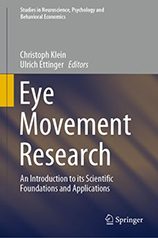
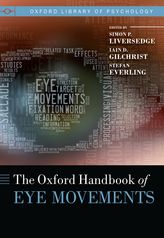
 When do babies track objects?
When do babies track objects?